Women's cue sports in Australia is a sporting topic that has received some Australian media coverage since the early 20th century. Coverage began with English billiards and today is more often about the sport of snooker and various pool games such as eight-ball.
Up until 1984 and the passage of the Commonwealth Sex Discrimination Act and state passed Equal Opportunity Acts, many sporting clubs were single sex. [1] Those that were not often made it difficult for women to participate in a club by prohibiting them from playing billiards and snooker at a club, setting hours that made it difficult for women to play and not allowing them to be on the board of club or having voting privileges at a club. [2]
English billiards in particular is one of several sports Australian women were noted as infrequently playing in the first half of the 20th century, but with encouragement from male professionals. The game enjoyed some popularity because of its connections to England. A daily competitive billiards match between two local women were reported as a human interest story in a South Australian newspaper in 1911. [3] and an amateur women's tournament was held in 1931.
However, in 1940, a study of 314 women in New Zealand and Australia showed less than 1 per cent of respondents played the game. Most of the women in the study were middle class, conservative, Protestant and white. The study found that 183 participated in sports. Billiards was tied with eight other activities as the ninth most popular sports in which these women participated, with 3 having played the sport. [4] [ clarification needed ]
Ruby Roberts was an Australian professional billiards player during the 1910s and 1920s. She returned to Australia in 1926. [5]
In 1931, the Canberra Times , in reporting on the advent of an amateur women's championship, asked why there were no great female billiards players. [6] Also that year, an Adelaide newspaper quoted Australian champion Walter Lindrum, one of the world's top billiards players, as saying that women should be able to be competitive with men at the sport. Observing increasing popularity of billiards among women in England, Lindrum was supportive of more opportunities for female Australian players. [7] Again in 1936, the retiring Lindrum tried to interest Australian women in taking up the sport. [8]
As of 2002 [update] , Australia had a national amateur women's snooker team. [9] In 2009, the team competed against New Zealand in a test series, and won, 25–23. [9] The inaugural Trans Tasman Test was played at the Penrith Panthers Club in 1997 between Australia (K.Parashis;T.Cantoni;L.Lucas;J.McCullough;S.Ridley) & New Zealand (L.Field;M.Woods;A.Moeahu;S.Wilkie;T.Gealey;C.Baillie;J.Woods) with NZ totally annihilating Australia. However, Australia redeemed themselves taking the Trans Tasman Test the next 3 consecutive years.
The 2009 ABSC/IBSF Australian Open Women's Snooker Championship was won by Kathy Parashis of Australia. [10] Only one Australian, 17-year-old Queenslander Jessica Woods, made the 2010 semi-finals. [11]
The amateur APPF/WEPF 2011 Ladies' Eight-ball Championship was won by Lyndall Hulley. [12]
Tammy Cantoni of Victoria, a multiple-time women's Australian national title-holder in both pool and snooker, and the runner-up in the 2009 open (mixed-gender) division of the Australian Nine-ball Championship, won the 1998 WPA World Nine-ball Championship (women's division). [13] [14]

Snooker is a cue sport played on a rectangular billiards table covered with a green cloth called baize, with six pockets, one at each corner and one in the middle of each long side. First played by British Army officers stationed in India in the second half of the 19th century, the game is played with twenty-two balls, comprising a white cue ball, fifteen red balls, and six other balls—a yellow, green, brown, blue, pink, and black—collectively called the colours. Using a cue stick, the individual players or teams take turns to strike the cue ball to pot other balls in a predefined sequence, accumulating points for each successful pot and for each time the opposing player or team commits a foul. An individual frame of snooker is won by the player who has scored the most points. A snooker match ends when a player reaches a predetermined number of frames.

English billiards, called simply billiards in the United Kingdom and in many former British colonies, is a cue sport that combines the aspects of carom billiards and pool. Two cue balls and a red object ball are used. Each player or team uses a different cue ball. It is played on a billiards table with the same dimensions as one used for snooker and points are scored for cannons and pocketing the balls.
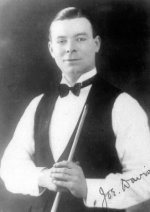
Joseph Davis was an English professional snooker and English billiards player. He was the dominant figure in snooker from the 1920s to the 1950s, and has been credited with inventing aspects of the way the game is now played, such as break-building. With the help of equipment manufacturer Bill Camkin, he drove the creation of the World Snooker Championship by persuading the Billiards Association and Control Council to recognise an official professional snooker championship in 1927. Davis won the first 15 world championships from 1927 to 1946, and he is the only undefeated player in World Snooker Championship history. In 1930, he scored the championship's first century break.
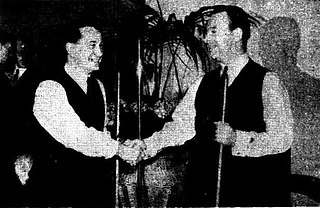
Horace Lindrum was an Australian professional player of snooker and English billiards. Lindrum won the 1952 World Snooker Championship defeating New Zealander Clark McConachy. The tournament is disputed, as it had only two participants, and other players boycotted the event to play in the 1952 World Professional Match-play Championship. Lindrum won the Australian Professional Billiards Championship on multiple occasions, first winning the event in 1934.

Walter Albert Lindrum, OBE, often known as Wally Lindrum, was an Australian professional player of English billiards who held the World Professional Billiards Championship from 1933 until his retirement in 1950. Being the first Lindrum born in Western Australia, he was named Walter Albert to have the initials of the state where he was born. He was one of the most successful players ever seen in billiards, with 57 world records to his credit, some of which still stand.
The World Billiards Championship is an international cue sports tournament in the discipline of English billiards, organised by World Billiards, a subsidiary of the World Professional Billiards and Snooker Association (WPBSA). In its various forms, and usually as a single competition, the title is one of the oldest sporting world championships, having been contested since 1870.
The 1935 World Snooker Championship was a snooker tournament held at Thurston's Hall in London, England from 8 to 27 April 1935. It was the first edition of the Championship to incorporate "world" in its name, being called the World's Professional Snooker Championship. Joe Davis won the title for the ninth time by defeating Willie Smith by 28 frames to 21 in the final, having achieved a winning margin at 25–20. Davis recorded the first century break in the history of the championship, a 110 in his semi-final match against Tom Newman.
The 1952 World Snooker Championship was a snooker tournament held between 25 February and 8 March 1952 at Houldsworth Hall, in Manchester, England. The event featured only two entrants – Australian Horace Lindrum and New Zealander Clark McConachy. Due to a dispute between the Professional Billiards Players' Association (PBPA) and the Billiards Association and Control Council (BACC), most players withdrew from the event. The BACC thought the championship was primarily about honour, and financial consideration should come second, whilst the PBPA disagreed. The PBPA established an alternative 'world championship' called the PBPA Snooker Championship which would later become the official world championship as the World Professional Match-play Championship.
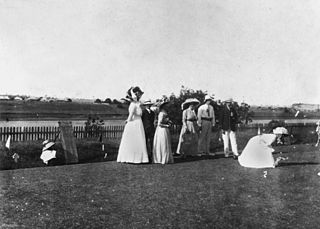
The first women's bowls match played in Australia took place in Stawell, Victoria, in October 1881. The first women's only bowls club was not created for another seventeen years, when the Rainsford Bowls Club was created on 16 December 1898 at the home of J. Rainsford Needham, who lived in Glenferrie, Victoria. The first women's bowls association was created in September 1907. The association was called the Victorian Ladies' Bowling Association, and was created by six Melbourne-based clubs. It was the first women's bowling association created the world.
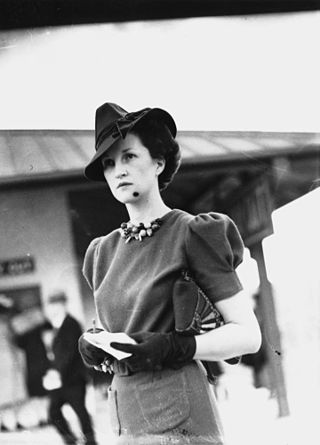
Women were involved with horse racing in Australia by the 1890s. Since then, they have owned horses, trained horses, gambled on horses and attended the races. Their participation in the sport was hampered because of a lack of facilities and participation rates were not as high as other sports.
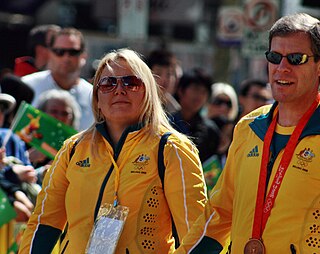
Shooting was an important skill for women in the bush to possess. It was encouraged as part of self-reliance. Rifle shooting as a sport was being played in Queensland by 1914.
In 1940, a study of 314 women in New Zealand and Australia was done. Most of the women in the study were middle class, conservative, Protestant and white. The study found that 183 participated in sport. The ninth most popular sport that these women participated in was squash, with three having played the sport. The sport was tied with croquet, billiards, chess, fishing, field hockey, horse racing, squash, table tennis and shooting.

Australia's fishing has been both an essential cultural pastime for women in pre-European Australia, and as a sport in recent times.

Women's chess in Australia has been occurring since the 1930s and competitive chess tournaments in Australia were taking place on a state level by 1934.
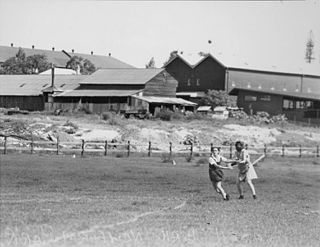
In the 1880s in Victoria, there were school competitions for girls involving interschool competitions for rounders, an early form of baseball. The competitions were abandoned in the 1890s. Girls who played rounders/baseball during the 1880s and 1890s were required to wear long sleeved shirts and long skirts. These restricted a player's ability to move.
In Australia, archery is a sport in which men and women compete against each other on an equal playing field. Coed competitions have occurred since Australia's colonial era. An example of one such competition took played in Yandilla, Queensland, in 1878. Women's archery was established in Victoria by the 1870s, mostly in archery clubs. People viewed women's archery as a royal sport during this era and they encouraged women to participate because it did not require women to give up their womanhood in order to compete. Women were members of an archery club in Adelaide by 1870.
During the 1970s and 1980s, Australian women's basketball was successful in terms of attracting participants and having a competitive team on the international stages. This success did not translate into sponsorship and financial support for the sport.